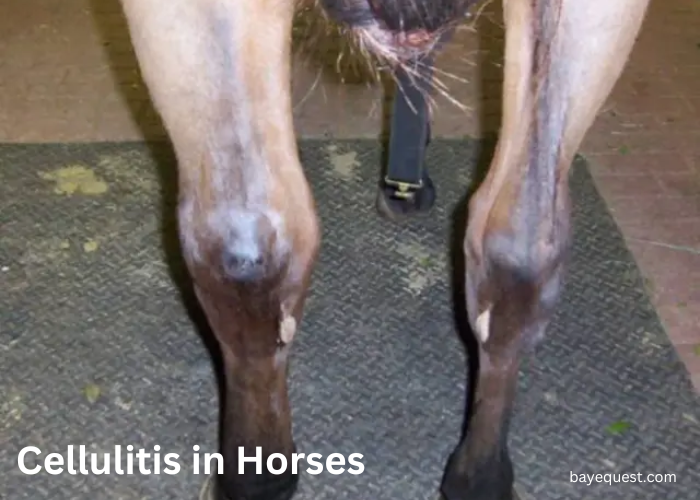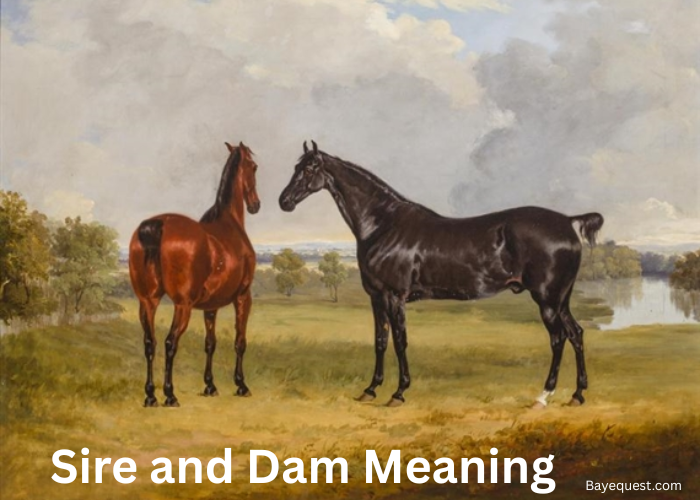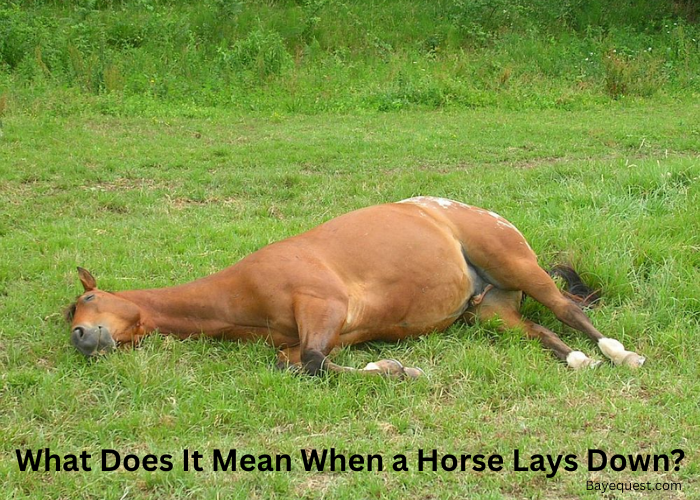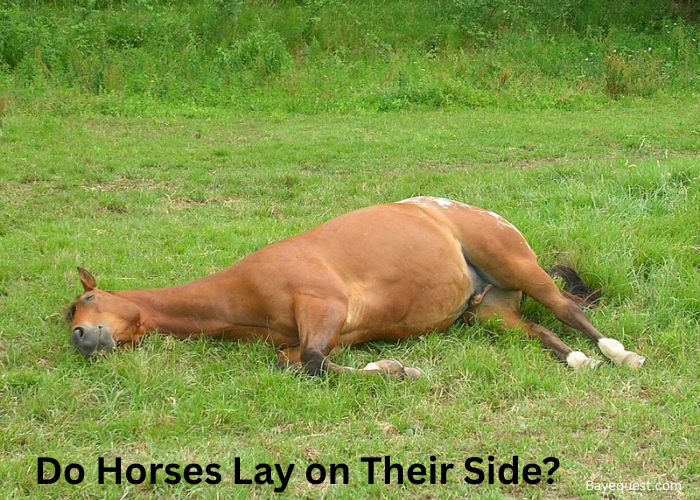Cellulitis in horses can appear out of nowhere. One day, your horse is fine, and the next, its leg is swollen and painful.
This sudden bacterial infection can spread quickly, making your horse uncomfortable and lame.
Early detection is key, and knowing the signs can save you a lot of trouble. But don’t worry—there are treatments that work.
In this blog, we’ll cover everything you need to know about cellulitis and how to keep your horse healthy.
Cellulitis in Horses: Key Takeaway
Cellulitis and lymphangitis in horses are common bacterial infections that cause swelling, pain, and lameness, often in the hindlimbs. These infections affect the skin, subcutaneous tissues, and sometimes the lymphatic system.
What is Equine Cellulitis?
Equine cellulitis is inflammation that affects the deep layers of the skin and the tissues beneath it.
Specifically, it involves the deep dermis and the subcutaneous tissues, which are the layers under the surface of the skin.
When bacteria get into these layers through a wound, they cause swelling, heat, and pain.
The infection spreads quickly and can lead to serious discomfort and lameness in horses if not treated right away.
How the Cellulitis Infection Develops
Cellulitis starts when bacteria, like Streptococcus or Staphylococcus, enter the body through a break in the skin.
This could be from a small cut, scrape, or insect bite.
Once the bacteria are inside, they begin to multiply in the dermis, and in the subcutaneous layer.
As the bacteria multiply, the body’s immune system responds by sending white blood cells to fight the infection.
This leads to inflammation, causing the affected area to become swollen, red, and hot.
The body’s increased blood flow to the area makes the infection site warm, while swelling and pain follow as the tissues become more irritated.
The bacteria also release toxins that further damage the surrounding tissue.
This can make the infection spread quickly through the limb, causing more swelling and discomfort.
If the infection isn’t treated, it can get worse, leading to more serious problems like tissue death or even spreading to the bloodstream.
Types of Cellulitis
There are two main types: primary and secondary. Let’s break down each type to see how they develop and what sets them apart.
Primary cellulitis
This type occurs when bacteria directly infect the skin and deeper tissues without any prior wound or injury.
It usually happens when the skin’s natural barriers are compromised, allowing bacteria to enter.
Primary cellulitis can appear suddenly and without an obvious cause.
Horses with weak immune systems or underlying health issues are more prone to primary cellulitis.
Secondary cellulitis
Secondary cellulitis, on the other hand, develops as a result of an existing injury, wound, or infection.
This means the bacteria enter the body through a cut, scrape, or other trauma to the skin.
Secondary cellulitis is more common because it follows a noticeable event, like a puncture wound or insect bite, which gives bacteria an easy point of entry.
Causes of Cellulitis in Horses
Cellulitis in horses can be triggered by various factors, some more noticeable than others. Here are the common causes:
Limb edema
Swelling in the limb can restrict circulation, creating a perfect environment for bacteria to thrive.
The trapped fluid allows infections to develop more easily, leading to cellulitis.
Joint or tendon sheath infections
When bacteria enter a joint or tendon sheath, often through an injury, they can spread rapidly to nearby tissues.
This makes cellulitis a common complication in such infections.
Improper bathing practices
Not drying a horse properly after bathing can weaken the skin’s natural barrier.
The trapped moisture makes it easier for bacteria to invade, increasing the risk of cellulitis.
Minor cuts or abrasions
Even the tiniest cuts or scrapes can open the door for bacteria to enter.
Once inside, bacteria can quickly infect deeper layers of the skin if not treated in time.
Insect bites, puncture wounds, or trauma
Bites, punctures, or any trauma to the skin can provide a direct entry point for bacteria.
Horses in areas with heavy insect activity are particularly at risk, as bites can easily lead to infection.
Pre-existing conditions
Conditions that weaken a horse’s immune system or affect circulation make them more vulnerable to cellulitis.
These underlying issues reduce the body’s ability to fight off bacteria, allowing infections to spread faster.
Interesting read: Swollen Horse Sheath Infection Symptoms.
Symptoms of Equine Cellulitis
Here’s a breakdown of the key symptoms of cellulitis in horses:
1. Dramatic and sudden swelling
This is one of the first signs. The affected limb often swells significantly within hours as fluid accumulates in the tissues.
This rapid swelling is due to the body’s inflammatory response to infection.
2. Severe pain
Horses with cellulitis experience intense pain, particularly in the swollen areas.
This pain is caused by pressure on the nerves from both the swelling and inflammation, making movement difficult.
3. Fever and lethargy
As the body fights the infection, fever develops.
This increase in body temperature is a sign of the immune system working to eliminate the bacteria.
Lethargy often accompanies fever, as the horse becomes weak and less energetic.
4. Wetness on the surface of the skin
In some cases, the skin may become moist or appear wet due to fluid leaking from the inflamed tissues.
This can be a sign that the infection is severe, and the skin barrier is breaking down.
5. Moderate to severe lameness
Due to the pain and inflammation, horses with cellulitis often become lame.
The severity of lameness depends on the extent of the swelling and the amount of tissue damage, making it difficult for the horse to move normally.
6. Warmth and sensitivity to touch
The infected area often feels warmer than normal because of increased blood flow to the site.
The tissues become highly sensitive, and even light touch can cause significant discomfort.
7. Pitting
When you press on the swollen area, it leaves an indentation, which is known as pitting.
This happens because the swelling is due to fluid accumulation, and the tissue doesn’t immediately spring back after being pressed.
8. Anorexia (Loss of appetite)
Horses with severe cellulitis may stop eating due to the pain, fever, and overall discomfort.
This loss of appetite is another sign that the infection is affecting their overall health.
9. Tachycardia
As the infection progresses, the horse’s heart rate may increase.
Tachycardia (a faster-than-normal heart rate) is often a response to pain, fever, and the body’s effort to circulate more blood to fight off the infection.
How is Cellulitis Diagnosed in Horses?
Diagnosing cellulitis requires a thorough approach to confirm the infection and understand how far it has spread.
Let’s take a closer look at the key ways cellulitis is diagnosed.
Physical examination
The vet starts by visually inspecting the horse and palpating the affected limb.
During the exam, the vet checks for classic signs like swelling, warmth, pain, and pitting.
This hands-on approach helps the vet determine the extent of the infection and rule out other causes of lameness or swelling.
Ultrasonography
Ultrasound uses sound waves to create images of the tissues beneath the skin.
This technique helps the vet see how deep the infection has spread, especially into the muscles or joints.
It’s also used to check for abscesses, fluid buildup, or any damage to the underlying structures.
Flow-phase scintigraphy
This is a more advanced imaging technique that involves injecting a radioactive substance into the horse’s bloodstream.
The substance highlights areas with abnormal blood flow, which is a common feature of cellulitis.
This method helps identify the exact location and extent of the infection, especially in difficult-to-diagnose cases.
Complete Blood Count (CBC)
A CBC is a blood test that checks the levels of different blood cells.
In horses with cellulitis, this test may show an increased number of white blood cells, which indicates the body is fighting an infection.
The CBC also helps assess the horse’s overall health and detect any signs of systemic infection or inflammation.
Treatment of Cellulitis in Horses
Treating cellulitis in horses often needs a mix of different treatments. Here’s a simple explanation of the most common ones:
Regional Limb Perfusion
RLP is a special method used to get high doses of antibiotics right to the infected part of the horse’s leg.
A band is placed around the leg above the infection to stop the blood flow for a short time.
Then, antibiotics are injected into a vein below the band, keeping the medicine in the infected area.
This way, the antibiotics can work much better on the infection than if they were given to the whole body.
RLP helps kill the bacteria faster and speeds up recovery. It’s usually done several times, depending on how bad the infection is.
This treatment also lowers the chance of side effects from antibiotics given to the whole body.
Antibiotics
Common antibiotics that are often used to fight the bacteria causing cellulitis are penicillin and gentamicin.
Another common option is trimethoprim-sulfa (TMS), which works against many types of bacteria.
The vet decides which antibiotic to use based on how bad the infection is and the type of bacteria involved.
The treatment usually lasts from a few days to a few weeks.
Corticosteroids
Corticosteroids are strong medicines that help reduce swelling and inflammation.
Drugs like dexamethasone or prednisolone are given to lower the immune system’s response to the infection, which helps control pain and swelling.
But these drugs must be used carefully. Too much can weaken the immune system and make it harder for the horse to fight the infection.
Find out the best administration of dexamethasone in our guide.
Cold hosing or icing
Cold water or ice is used to bring down the swelling in the infected leg.
Cold therapy slows the blood flow to the area, which helps manage inflammation.
This is a simple and effective way to make the horse feel better and reduce swelling.
Dimethyl sulfoxide (DMSO)
DMSO is a strong anti-inflammatory treatment that soaks through the skin easily.
It’s put on the skin to reduce swelling and pain in the infected area.
It also helps other medicines reach the deeper tissues, making them work better.
How to Manage Equine Cellulitis
Managing equine cellulitis requires quick action and careful care. Here are some key steps:
1. Call the vet immediately
Early treatment is critical. The vet can diagnose and start the right treatment to stop the infection from spreading.
2. Follow the vet’s treatment plan
Give all prescribed medications, such as antibiotics and anti-inflammatory drugs, as directed. Be consistent with doses.
3. Cold therapy
Use cold hosing or ice packs on the swollen area. This helps reduce swelling and ease pain.
4. Rest the horse
Limit the horse’s movement to prevent further damage and allow healing. Keep them in a clean, quiet area.
5. Monitor swelling and symptoms
Watch for changes in swelling, temperature, or pain. Notify the vet if symptoms worsen or don’t improve.
6. Keep the wound clean
If there’s an open wound, clean it daily to prevent bacteria from entering and causing more infection.
7. Use proper bandaging
If advised by the vet, wrap the affected limb to provide support and reduce swelling. Change the bandages regularly.
8. Provide good nutrition
Ensure the horse gets a balanced diet to support the immune system and recovery process.
Interesting read: What is Exuberant Granulation Tissue?
What is the Prognosis of Cellulitis in Horses?
The prognosis for horses with cellulitis depends on how quickly treatment begins.
If caught early and treated properly, most horses recover well, with around 70-80% returning to normal function.
However, severe cases or delayed treatment can lead to long-term issues, like permanent swelling or lameness, which affect about 20-30% of horses.
In some cases, cellulitis can reoccur, especially if the horse has underlying health issues.
With quick action and the right care, many horses can recover fully and avoid complications.
Related read: What is the Prognosis of a Horse Broken Leg?
Prevention of Equine Cellulitis
Here’s how you can help protect your horse against equine cellulitis:
1. Proper wound care and hygiene
Clean any cuts or scrapes right away and apply appropriate treatments. Keeping wounds clean helps prevent bacteria from entering.
2. Monitoring for early signs of infections
Check your horse daily for signs of swelling, heat, or pain. Catching early signs can prevent a small issue from becoming a bigger problem.
3. Regular grooming and checking for cuts or abrasions
Groom your horse often and check for any skin injuries. Even small cuts can become a source of infection if left untreated.
4. Insect control and fly protection
Use fly sprays, masks, and other protection to reduce insect bites, which can lead to cellulitis. Controlling insects helps lower the risk of skin irritation and infection.
Cellulitis Vs Lymphangitis
Cellulitis and lymphangitis both cause swelling in a horse’s limb, but they develop differently.
Cellulitis is a sudden bacterial infection that leads to rapid swelling, heat, and pain.
It often happens after a cut or injury, and the infection spreads quickly through the tissue.
Lymphangitis, on the other hand, affects the lymphatic vessels and usually starts with swelling in the lower limb, spreading slowly upward.
While cellulitis is more acute, lymphangitis can become a long-term condition with thickening of the skin.
Both need immediate treatment, but lymphangitis may require extra therapies to manage swelling over time.
FAQs
How long does it take cellulitis to heal in horses?
Cellulitis can take anywhere from a few days to several weeks to heal. This depends on the severity of the infection and how quickly treatment is started. With proper care and medication, most horses begin to show improvement within a few days, but full recovery may take longer.
Does cellulitis in horses go away?
Yes, with timely and appropriate treatment, cellulitis can go away. However, some cases may lead to long-term swelling or reoccurrence, especially if the infection was severe or if there are underlying conditions.
Is there a breed predisposition for cellulitis?
There is no specific breed predisposition for cellulitis. Any horse can develop cellulitis if the right conditions are present, such as skin trauma or infection. However, horses with compromised immune systems or those prone to leg injuries may be at higher risk.
Is cellulitis more common in the fore or hindlimbs?
Cellulitis is more commonly seen in the hindlimbs, though it can occur in the forelimbs as well. The condition often affects one limb, but in some cases, more than one limb may be involved.
Conclusion
Cellulitis in horses can be scary, but the key is acting fast. Early treatment can make all the difference.
Keep an eye on any swelling, warmth, or sudden lameness. Call your vet right away if you notice something off.
With proper care, most horses recover quickly and get back to normal.
Prevention is also important—keep wounds clean and watch for signs of infection.
By staying alert and proactive, you can help protect your horse from the worst effects of cellulitis and keep them healthy.
Now, check out our article on “Ventral Edema in Horses” to learn more about this condition and understand the possible causes.








